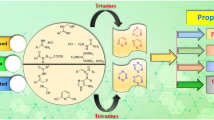Abstract
Cancer today remains one of the most deadly diseases in the world. In search of novel anticancer agents, a series of newly hybrid molecules were designed and synthesized by combining the structural features of nucleobase and barbiturate derivatives using the concept of green chemistry. This approach was accomplished efficiently using the aqueous medium to give the corresponding products in a high yield. The newly synthesized compounds were characterized by spectral analysis FT-IR, 1H NMR, 13C-NMR, HMBC, MASS and elemental analysis. Evaluations of these molecules over four cell lines panel of human cancer cells have identified several compounds with significant anticancer activities against one or more cell lines. Compounds TBC and TBA proved to exhibit a wide cytotoxic effect on the tested four cell lines at (IC50 16–24 μM) and (IC50 25–34 μM), respectively. Other compounds, e.g., 1,3-BA, showed a selective cytotoxicity against HepG2 at 7 μM. Taken together, this study has led to the development of a convenient, a highly yielded, and an environmentally friendly synthetic method of highly promising leads for cancer fighting.



Similar content being viewed by others
References
Blicke FF, Lu CJ (1952) Formylation of amines with chloral and reduction of the N-formyl derivatives with lithium aluminum hydride. J Am Chem Soc 74(15):3933–3934
Chen FMF, Benoiton NL (1979) A general method for formylating sensitive amino acid esters. Synthesis 9:709–710
Dawane BS, Bandgar BP, Kinkar SN, Chobe SS, Mandawad GG, Yemul OS (2011) Clean and green approach for N-formylation of amines using formic acid under neat reaction condition. Arch App Sci Res 3(3):246–251
Dhorajiya BD, Dholakiya BZ (2013) Res Chem Intermed. doi:10.1007/S11164-013-1190-4
Dhorajiya BD, Bhakhar BS, Dholakiya BZ (2012) Synthesis, characterization, solvatochromic properties and antimicrobial evaluation of 5-acetyl-2-thioxo-dihydro-pyrimidine-4,6-dione-based chalcones. Med Chem Res. doi:10.1007/S00044-012-0395-1
Duezek W, Deutsch J, Vieth S, Niclas HJ (1996) A simple and convenient synthesis of N-formyl amino acid esters under mild conditions. Synthesis 1:37–38
Fadda AA, El Defrawy AM, El-Hadidy SA (2012) Synthesis, cytotoxicity evaluation, DFT molecular modeling studies and quantitative structure activity relationship of novel 1,8-Naphthyridines. Am J Org Chem 2:87–96
Green TW, Wuts PGM (1999) Protective groups in organic synthesis, 3rd edn. Wiley-Intersciences, New York
Huang LYM, Barker JL (1980) Pentobarbital stereospecific actions of (+) and (−) isomers revealed on cultured mammalian neurons. Science 207:195–197
Jacobson (1937) U. S. pat. 2,090, 594, [C. A. 31, 7068]
Kisfaludy L, Laszlo O (1987) Rapid and selective formylation with pentafluorophenyl formate. Synthesis 5:510
Luca LD, Giacomelli G, Porcheddu A, Salaris M (2004) A new, simple procedure for the synthesis of formyl amides. Synlett 14:2570–2572
Miharam M, Ishino Y, Minakata S, Komatsu M (2003) Convenient N-formylation of secondary amines: KF–Al2O3-promoted synthesis of formamide derivatives via dichlorocarbene generated from chloroform. Synthesis 15:2317–2320
Nerveux M, Bruneaum C, Dixneuf PH (1991) Enol formates: ruthenium catalysed formation and formylating reagents. J Chem Soc Perkin Trans 5:1197–1199
Nicoll RA, Wojtowicz JM (1980) The effects of pentobarbital and related compounds on frog motoneurons. Brain Res 191(1):225–237
Reddy PG, Kumar GDK, Baskaram S (2000) A convenient method for the N-formylation of secondary amines and anilines using ammonium formate. Tetrahedron Lett 41(47):9149–9151
Silverstein RM, Webster FX (1997) Spectrometric identification of organic compounds, 6th edn. Wiley, New York, pp 79–223
Strazzolini P, Giumanini AG, Cauci S (1990) Acetic formic anhydride. Tetrahedron 46:1081–1118
Waki M, Meienhofer J (1977) Efficient preparation of N.Sup., alpha.-Formylationamino acid tert-butyl esters. J Org Chem 42(11):2019–2021
Yale HL (1971) Formylation of amines with phenyl formate. J Org Chem 36(21):3238–3240
Acknowledgments
We are very much thankful to the Department of Applied Chemistry, SVNIT, Surat for providing laboratory facilities, financial Support from Gujarat Council on Science and Technology (Project No. GUJCOST/MRP/202042/12-13/04/1319). For characterization, we are thankful to Mr. D. M. Thumar (Vice President) from Amoli Organic Pvt, Ltd, Baroda, Gujarat and Avtarsingh & Manishkumar from SAIF, Punjab University, Chandigarh, India.
Author information
Authors and Affiliations
Corresponding author
Electronic supplementary material
Below is the link to the electronic supplementary material.
Rights and permissions
About this article
Cite this article
Dhorajiya, B.D., Ibrahim, A.S., Badria, F.A. et al. Design and synthesis of novel nucleobase-based barbiturate derivatives as potential anticancer agents. Med Chem Res 23, 839–847 (2014). https://doi.org/10.1007/s00044-013-0683-4
Received:
Accepted:
Published:
Issue Date:
DOI: https://doi.org/10.1007/s00044-013-0683-4




